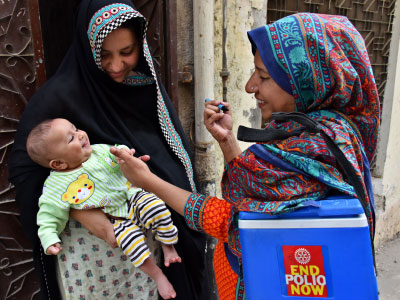Background

In 1988, the World Health Assembly adopted a resolution for the worldwide eradication of polio. This marked the launch of the Global Polio Eradication Initiative (GPEI); a public-private partnership spearheaded by national governments, the World Health Organization, Rotary International, the US Centers for Disease Control and Prevention (CDC), and UNICEF. The GPEI was later joined by the Bill & Melinda Gates Foundation and Gavi, the Vaccine Alliance.
The GPEI, along with its partners, has helped countries to make huge progress in protecting the global population from the poliovirus. As a result, global incidence of polio has decreased by 99.9% since GPEI’s foundation.
The goal of the GPEI is to ensure that no child will ever again be paralyzed by any poliovirus. To achieve this goal, the GPEI has established standard operating procedures (SOPs) to provide:
- Guidance on how to respond to a poliovirus event or outbreak.
- Performance standards for an effective and timely response.
This elearning course is designed to work through the polio outbreak response standard operating procedures, provide high-level information and contextual understanding of polio outbreak response strategies.
Course objectives
At the end of this course, you will be able to:
- Outline the role of the GPEI partnership in outbreak response activities.
- List the essential components of a successful response.
- Explain the process and timeline of notification, investigation and risk assessment.
- Describe the actions required as part of detailed outbreak response planning.
- Describe the four-step vaccination strategy for outbreak response.
- Outline communication strategies to support vaccination.
- Describe strategies for enhancing surveillance.
- Outline the response activities that continue until and after outbreak close.
Audience
The elearning course is designed for current and incoming polio staff who will work on outbreak response activities and anyone interested to learn more about polio outbreak response.
Length
It should take you approximately four hours to complete this self-paced course.
Methodology
This course utilizes multimedia and interactive presentation components to introduce learning material on polio outbreak response procedures.
The content is structured in short modules, designed to break the learning content into manageable chunks of information for self-paced learning. The modules follow the sequence of tasks and activities in the target polio outbreak response timeline.
The modules contain “course questions” to prompt thinking and engagement, and each module concludes with a knowledge check. The knowledge checks are intended to support the learning process, so do not worry if you don't get all the questions correct.
An end-of-course assessment can be used to test knowledge of all modules. Participants can gain a certificate by achieving more than 80%.
Supplementary reading and support materials are also provided in each module, through the Resources tab, and in the Course Resources Repository.
For support on using the course, please refer to the Getting Started section.
Structure
This course consist of seven modules and a final assessment:
- Module 1: Introduction to Polio Outbreak Response
- Module 2: Notification, Investigation and Risk Assessment
- Module 3: Planning for a Response
- Module 4: Communication Strategies
- Module 5: Response Activities: Immunization
- Module 6: Response Activities: Surveillance
- Module 7: Response Activities to Closure of Outbreak
- Final Course Assessment (Certificate available on successful completion.)
Find out more about polio outbreak response and the Global Polio Eradication Initiative at http://polioeradication.org/

